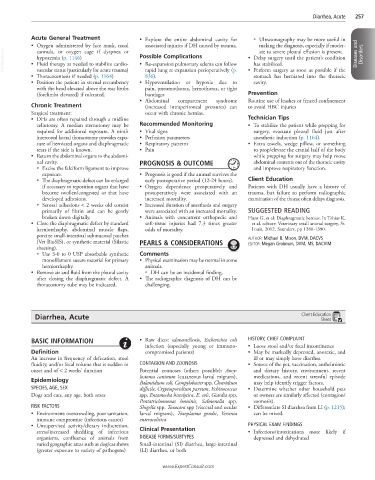Page 570 - Cote clinical veterinary advisor dogs and cats 4th
P. 570
Diarrhea, Acute 257
Acute General Treatment • Explore the entire abdominal cavity for ○ Ultrasonography may be more useful in
• Oxygen administered by face mask, nasal associated injuries if DH caused by trauma. making the diagnosis, especially if moder-
VetBooks.ir • Fluid therapy as needed to stabilize cardio- Possible Complications • Delay surgery until the patient’s condition Diseases and Disorders
cannula, or oxygen cage if dyspnea or
ate to severe pleural effusion is present.
hypoxemia (p. 1146)
has stabilized.
• Re-expansion pulmonary edema can follow
vascular status (particularly for acute trauma)
836).
stomach has herniated into the thoracic
• Thoracocentesis if needed (p. 1164) rapid lung re-expansion perioperatively (p. • Perform surgery as soon as possible if the
• Position the patient in sternal recumbency • Hypoventilation or hypoxia due to cavity.
with the head elevated above the rear limbs pain, pneumothorax, hemothorax, or tight
(forelimbs elevated) if tolerated. bandages Prevention
• Abdominal compartment syndrome Routine use of leashes or fenced confinement
Chronic Treatment (increased intraperitoneal pressures) can to avoid HBC injuries
Surgical treatment: occur with chronic hernias.
• DHs are often repaired through a midline Technician Tips
celiotomy. A median sternotomy may be Recommended Monitoring • To stabilize the patient while prepping for
required for additional exposure. A ninth • Vital signs surgery, evacuate pleural fluid just after
intercostal lateral thoracotomy provides expo- • Perfusion parameters anesthetic induction (p. 1164).
sure of herniated organs and diaphragmatic • Respiratory patterns • Extra towels, wedge pillow, or something
tears if the side is known. • Pain to prop/elevate the cranial half of the body
• Return the abdominal organs to the abdomi- while prepping for surgery may help move
nal cavity. PROGNOSIS & OUTCOME abdominal contents out of the thoracic cavity
○ Excise the falciform ligament to improve and improve respiratory function.
exposure. • Prognosis is good if the animal survives the
○ The diaphragmatic defect can be enlarged early postoperative period (12-24 hours). Client Education
if necessary to reposition organs that have • Oxygen dependence preoperatively and Patients with DH usually have a history of
become swollen/congested or that have postoperatively were associated with an trauma, but failure to perform radiographic
developed adhesions. increased mortality. examination of the thorax often delays diagnosis.
○ Serosal adhesions < 2 weeks old consist • Increased duration of anesthesia and surgery
primarily of fibrin and can be gently were associated with an increased mortality. SUGGESTED READING
broken down digitally. • Animals with concurrent orthopedic and Hunt G, et al: Diaphragmatic hernias. In Tobias K,
• Close the diaphragmatic defect by standard soft-tissue injuries had 7.3 times greater et al, editors: Veterinary small animal surgery, St.
herniorrhaphy, abdominal muscle flaps, odds of mortality. Louis, 2012, Saunders, pp 1380-1390.
porcine small-intestinal submucosal patches AUTHOR: Michael B. Mison, DVM, DACVS
(Vet BioSIS), or synthetic material (Silastic PEARLS & CONSIDERATIONS EDITOR: Megan Grobman, DVM, MS, DACVIM
sheeting).
○ Use 3-0 to 0 USP absorbable synthetic Comments
monofilament suture material for primary • Physical examination may be normal in some
herniorrhaphy. animals.
• Remove air and fluid from the pleural cavity ○ DH can be an incidental finding.
after closing the diaphragmatic defect. A • The radiographic diagnosis of DH can be
thoracostomy tube may be indicated. challenging.
Diarrhea, Acute Client Education
Sheet
BASIC INFORMATION • Raw diets: salmonellosis, Escherichia coli HISTORY, CHIEF COMPLAINT
infection (especially young or immuno- • Loose stool and/or fecal incontinence
Definition compromised patients) • May be markedly depressed, anorexic, and
An increase in frequency of defecation, stool ill or may simply have diarrhea
fluidity, and/or fecal volume that is sudden in CONTAGION AND ZOONOSIS • Source of the pet, vaccination, anthelmintic
onset and of < 2 weeks’ duration Potential zoonoses (others possible): Ancy- and dietary history, environment, recent
lostoma caninum (cutaneous larval migrans), medications, and recent stressful episode
Epidemiology Balantidium coli, Campylobacter spp, Clostridium may help identify trigger factors.
SPECIES, AGE, SEX difficile, Cryptosporidium parvum, Echinococcus • Determine whether other household pets
Dogs and cats, any age, both sexes spp, Entamoeba histolytica, E. coli, Giardia spp, or owners are similarly affected (contagion/
Pentatrichomonas hominis, Salmonella spp, zoonosis).
RISK FACTORS Shigella spp, Toxocara spp (visceral and ocular • Differentiate SI diarrhea from LI (p. 1215);
• Environment: overcrowding, poor sanitation, larval migrans), Toxoplasma gondii, Yersinia can be mixed.
immune compromise (infectious causes) enterocolitica
• Unsupervised activity/dietary indiscretion, Clinical Presentation PHYSICAL EXAM FINDINGS
stress/increased shedding of infectious • Infections/intoxications more likely if
organisms, confluence of animals from DISEASE FORMS/SUBTYPES depressed and dehydrated
varied geographic areas such as dog/cat shows Small-intestinal (SI) diarrhea, large-intestinal
(greater exposure to variety of pathogens) (LI) diarrhea, or both
www.ExpertConsult.com

